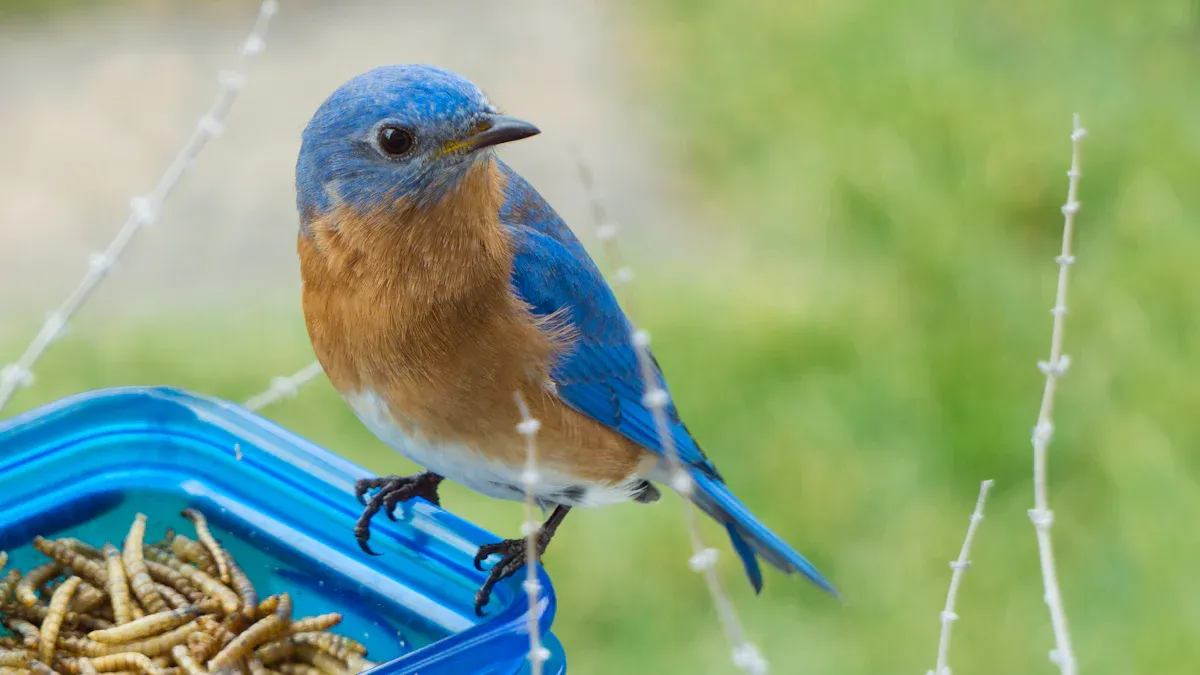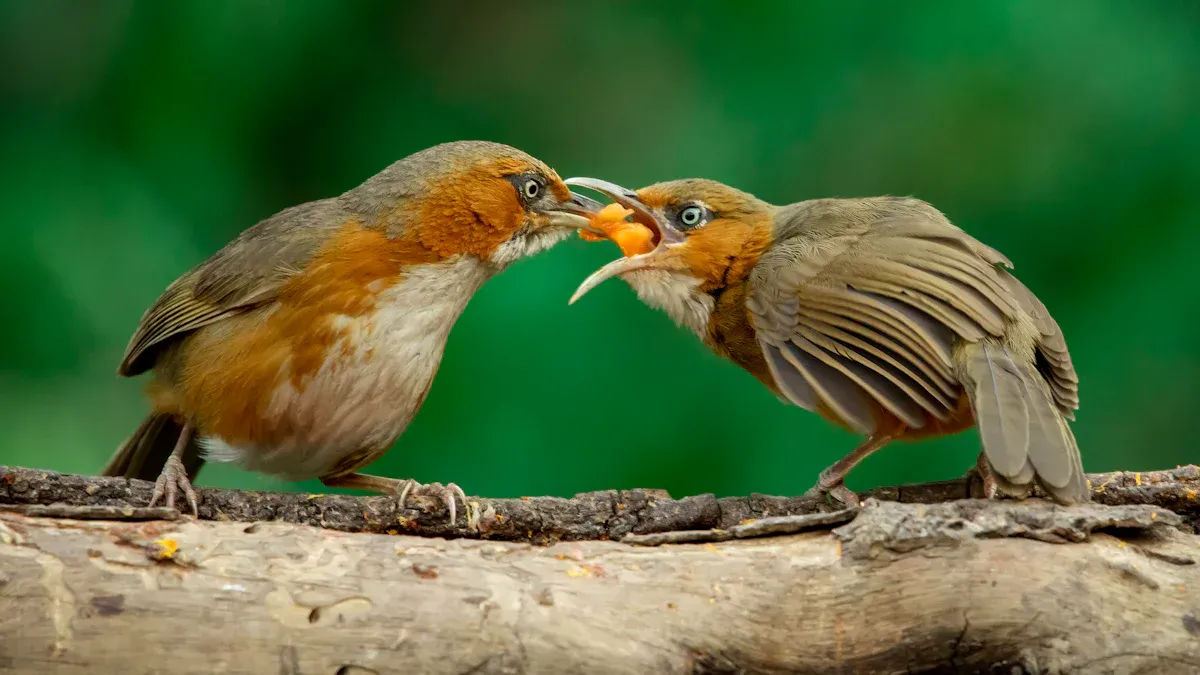
Birds thrive when they have access to high-quality food, and dried mealworms are a fantastic option. Packed with protein and energy, they help keep birds strong and active. A mealworm feeder for birds makes it easy to offer these treats while turning your backyard into a lively hub for colorful feathered visitors.
Key Takeaways
- Dried mealworms are full of protein and fat. They give birds lots of energy, especially during breeding and migration times.
- A mealworm feeder keeps them easy to reach and clean. This helps attract many bird types to your yard all year.
- Soaking dried mealworms in water makes them softer. This makes them more appealing to birds, especially for feeding baby birds.
Why Dried Mealworms Are Beneficial for Birds

Nutritional Value: High Protein and Fat Content
Dried mealworms are a powerhouse of nutrition for birds. They contain 53% protein and 28% fat, making them an excellent energy source. Birds need protein to maintain strong muscles, feathers, and overall health. Fat provides the energy they require for daily activities like flying, foraging, and staying warm during colder months.
Compared to live mealworms, dried ones offer a higher concentration of nutrients. Here’s a quick comparison:
| Nutritional Component | Live Mealworms | Dried Mealworms |
|---|---|---|
| Moisture | 62% | 5% |
| Lipid (Fat) | 13% | 28% |
| Protein | 20% | 53% |
| Ash | 1.5% | 4.1% |
| Carbohydrate | 3.1% | 8.5% |
This table highlights how dried mealworms pack more protein and fat into every bite. Birds benefit from this concentrated nutrition, especially during demanding periods like migration or breeding.

Year-Round Feeding Benefits
Dried mealworms are versatile and can be fed to birds throughout the year. In spring and summer, they help birds meet the increased energy demands of nesting and raising chicks. During fall and winter, they provide the extra calories birds need to survive cold nights and harsh weather.
Unlike live mealworms, dried ones have a long shelf life, making them a convenient option for year-round feeding. You can store them easily and offer them in small quantities as needed. A mealworm feeder for birds is a great way to present these treats, ensuring they stay clean and accessible.
Supporting Birds During Breeding and Migration Seasons
Birds face significant challenges during breeding and migration seasons. They need extra energy to build nests, lay eggs, and care for their young. Similarly, migration requires stamina and strength to travel long distances. Dried mealworms, with their high protein and fat content, provide the essential nutrients birds need during these demanding times.
Research shows that diets enriched with insect meal, like dried mealworms, can improve weight gain and overall health in birds. For example:
| Study | Findings |
|---|---|
| Zadeh et al. (2019) | Birds fed a diet with 30 g/kg insect meal had significantly higher carcass yield compared to those fed lower levels of mealworm. |
| Elahi et al. (2020) | Reported that dietary dried mealworm meal increased starter body weight gain both quadratically and linearly. |
| Biasato et al. (2017) | Found improvements in weight gain in chickens offered diets containing Tenebrio molitor meal compared to those on a basal diet. |
By offering dried mealworms during these critical periods, bird enthusiasts can play a vital role in supporting their feathered friends’ health and survival.
Birds That Are Attracted to Dried Mealworms

Common Backyard Birds
Dried mealworms are a favorite among many backyard birds. Species like robins, bluebirds, and blackbirds often flock to feeders offering this protein-packed treat. These birds rely on insects as a natural part of their diet, making mealworms an easy substitute. A mealworm feeder for birds can help keep the worms accessible while preventing waste.
Bird population studies show that live mealworms are sometimes preferred because of their movement, which mimics natural prey. However, dried mealworms still attract adult birds, especially when other food sources are scarce. Their convenience and long shelf life make them a practical choice for bird enthusiasts.
Seasonal and Migratory Visitors
During migration seasons, dried mealworms can become a lifeline for traveling birds. Research highlights how food availability impacts migratory birds’ energy reserves. Birds stopping in residential gardens often prioritize finding high-energy food to refuel for their journey. Offering dried mealworms during these times can make your garden a popular stopover.
In spring, you might notice warblers or orioles visiting your feeders. In fall, sparrows and thrushes may appear as they prepare for their long flights. These seasonal visitors bring excitement and variety to your backyard birdwatching experience.
Introducing New Species to Your Garden
Adding dried mealworms to your feeding routine can attract species you’ve never seen before. Birds that primarily eat insects, such as wrens or chickadees, may start visiting your garden. Over time, these new guests could become regular visitors.
To encourage this, try combining dried mealworms with other foods like seeds or suet. This mix appeals to a broader range of birds. By diversifying your offerings, you create a welcoming environment for both familiar and new feathered friends.
Advantages of Dried Mealworms Over Live Mealworms
Convenience and Long Shelf Life
Dried mealworms offer unmatched convenience for bird enthusiasts. Unlike live mealworms, which require constant care and feeding, dried mealworms are ready to use straight out of the bag. Their extended shelf life means you can stock up without worrying about spoilage.
Tip: Our 1kg bag of dried mealworms is perfect for long-term use. For smaller needs, try our 100g or 500g bags.
This convenience makes them ideal for those who want to keep their bird feeders stocked without frequent trips to the store. Whether it’s summer or winter, dried mealworms stay fresh and nutritious, ensuring birds always have access to a reliable food source.
Easy Storage and Handling
Storing dried mealworms is a breeze. They don’t need refrigeration or special containers. A cool, dry place is all it takes to keep them in top condition. Their lightweight and compact packaging also make them easy to handle and transport.
For example, our dried mealworms come in resealable bags, which help maintain freshness and prevent spills. This feature is especially useful for those who enjoy bird feeding while traveling or camping.
Ideal for Busy Bird Enthusiasts
Life gets busy, but that doesn’t mean your feathered friends have to miss out. Dried mealworms save time and effort. There’s no need to clean up after messy live worms or deal with the hassle of keeping them alive.
With dried mealworms, bird lovers can focus on the joy of watching their garden visitors instead of worrying about maintenance. It’s a simple, stress-free way to support local wildlife while enjoying the beauty of nature.
Practical Tips for Feeding Dried Mealworms
Using a Mealworm Feeder for Birds
A mealworm feeder for birds is one of the easiest ways to offer dried mealworms to your feathered visitors. These feeders are designed to keep the mealworms accessible while preventing them from scattering or getting wet. Many bird species are drawn to feeders that offer this protein-packed treat, including:
- American Robins
- Blackbirds
- Cardinals
- Chickadees
- Finches
- Grackles
- Nuthatches
- Orioles
- Sparrows
- Tufted Titmice
- Warblers
- Wrens
- Woodpeckers
Mealworms provide essential protein and fat, making them a valuable addition to a bird’s diet. Adult birds often feed them to their chicks, ensuring the young ones grow strong and healthy. Placing a mealworm feeder for birds in your garden can attract a wide variety of species, turning your backyard into a lively birdwatching spot.
To get the best results, position the feeder in a quiet, shaded area. Birds feel safer when feeders are near shrubs or trees, which offer cover from predators. Regularly clean the feeder to keep it hygienic and appealing.
Soaking Mealworms to Enhance Appeal
Dried mealworms are already a favorite among birds, but soaking them in water can make them even more irresistible. Rehydrating the mealworms softens their texture, mimicking the feel of live insects. This small step can encourage more birds to visit, especially during breeding seasons when parents seek soft food for their chicks.
To soak mealworms, place them in a bowl of warm water for about 20-30 minutes. Once they’ve absorbed the water, drain the excess liquid and serve them in your mealworm feeder for birds. This method not only enhances their appeal but also provides birds with extra hydration, which is particularly helpful during hot summer days or dry weather.
Combining Mealworms with Other Bird Foods
While dried mealworms are a nutritious treat, combining them with other bird foods can attract an even greater variety of species. Mixing mealworms with seeds, suet, or fruit creates a balanced offering that appeals to both insect-eating and seed-eating birds.
For example, sprinkle a handful of dried mealworms over a tray of sunflower seeds or mix them into a suet cake. This combination can entice birds like bluebirds, wrens, and chickadees, while also drawing in finches and sparrows. By diversifying the menu, you create a welcoming environment for a broader range of birds.
If you’re new to bird feeding, start with smaller quantities to see what works best for your local bird population. Our 100g or 500g bags of dried mealworms are perfect for beginners. For those with more experience or larger bird populations, the 1kg bag offers great value and convenience.
Feeding birds dried mealworms offers a simple way to support their health and attract more species to your garden. These nutritious snacks provide essential nutrients, especially when natural food is scarce.
- They benefit nestlings and breeding birds.
- They enhance species diversity in gardens.
- They attract a variety of bird species year-round.
Try dried mealworms today and enjoy a vibrant, bird-filled garden!
Article author: Felix
FAQ
What is the best way to store dried mealworms?
Keep dried mealworms in a cool, dry place. Use resealable bags to maintain freshness and prevent spills. Proper storage ensures they stay nutritious and ready to use.
Can dried mealworms attract birds year-round?
Yes! Birds enjoy dried mealworms in every season. They provide energy during winter and support nesting birds in spring. They’re a versatile treat for all-year feeding.
How much should I feed birds at one time?
Offer small amounts, especially if you’re new to bird feeding. Start with a handful and adjust based on how quickly birds consume them. Avoid overfeeding to prevent waste.


